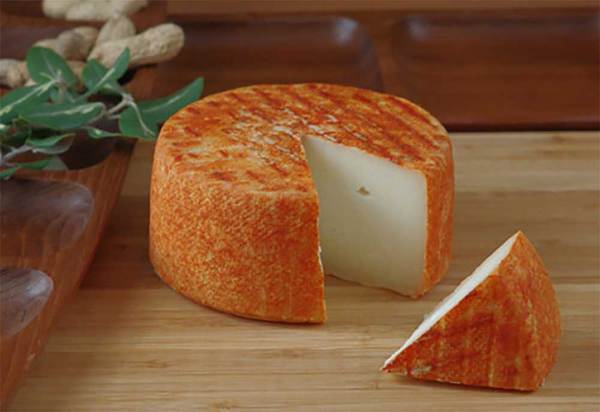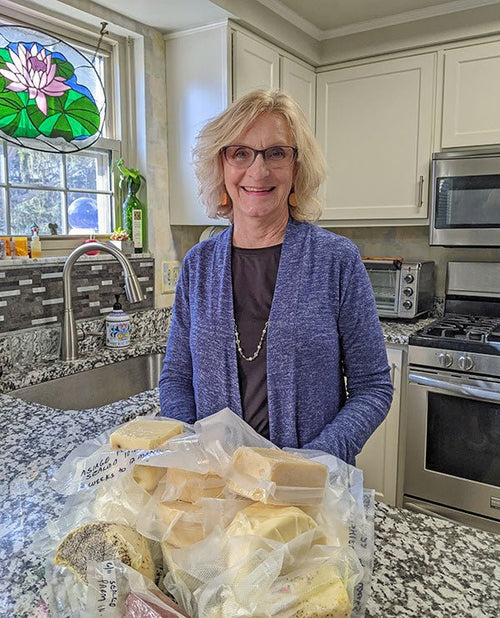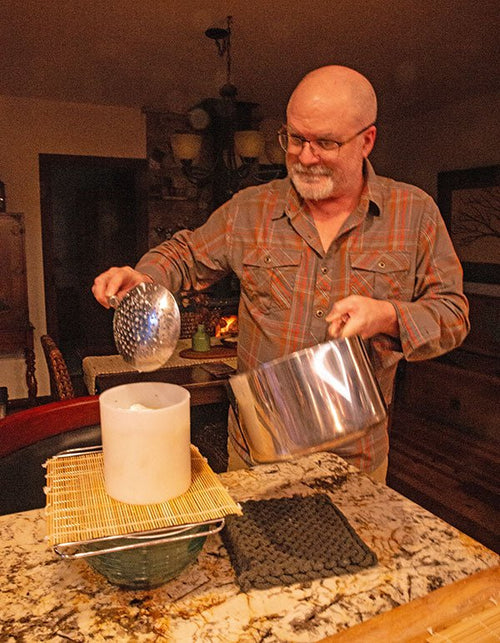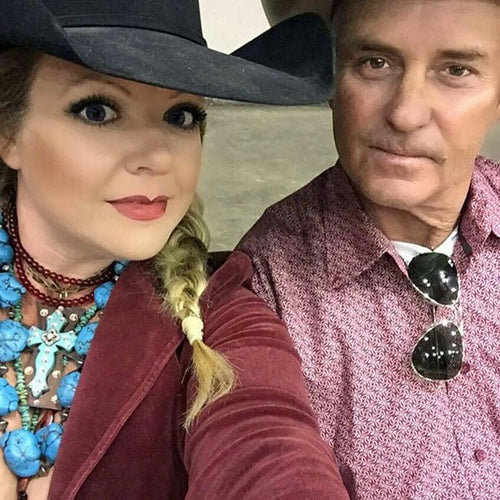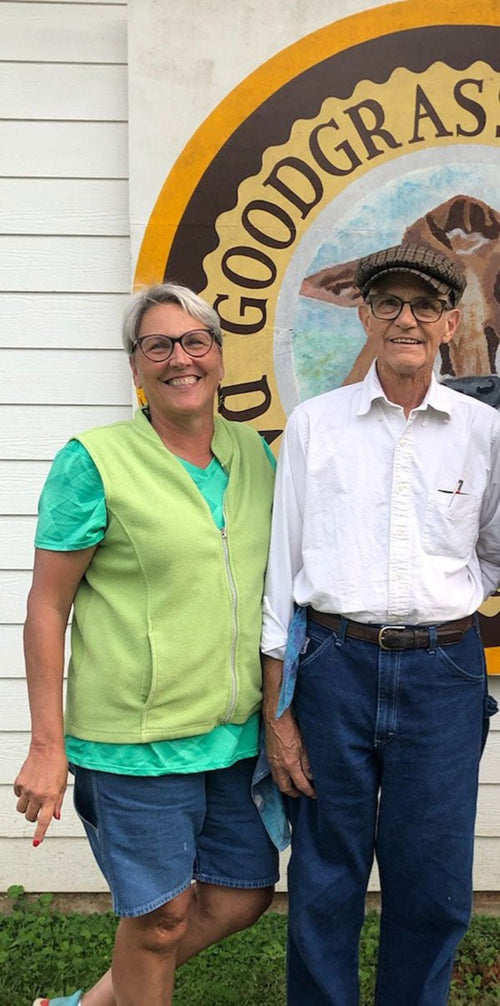Cheese Making Recipe of the Month
Bel Paese
Jim says that if Italy had a national cheese, this would be it. It is definitely one of the most popular cheeses in that bel paese (beautiful country).
When you make it, you will be using both mesophilic and thermophilic cultures. When you add the rennet, the temperature will be 108F, which is the highest renetting temperature of any cheese Jim has presented so far.
The result is a semi-soft cheese with a creamy, buttery taste. It may be served at the table, melted in sauces, or even used as a substitute for mozzarella in pizza, etc. Questa e una bella formaggio!
Cheese Making Questions & Answers
Keeping Brine
Q. How long can I continue re-using a brine solution if I boil it after each use and then keep it refrigerated?
A. If a brine is carefully maintained, it can be used for many years:
- Keep it cool (below 54F)
- Maintain the salt at saturation
- Filter the brine after every use
My brine here is many years old and I maintain it after every use. Please see our brining page for more details on this.
Using Fresh Starter Culture
Q. I got the Fresh Starter (C3) culture in your Goat Cheese Kit and I froze at least 2 quarts of it in ice cube trays for future use. The French chevre has turned out great. I found a local farmer who will give away her extra unpasteurized goat"s milk for a small donation. But, alas, I have frozen more culture than I have available goat's milk. So, I am wondering what cheeses I can make using cow's milk besides cottage cheese and Neufchatel.
A. You can use this fresh prepared culture for many harder cheeses such gouda or anything that calls for buttermilk or aromatic culture - MM100 or Flora Danica. Use the prepared culture at a rate of 1-2% of your milk in the vat.
Weeping Blue
Q. I may or may not have a problem with my cheese. Six weeks ago I made blue cheese and the blue has taken over! The entire wheel is a dark blue. Now I understand that the milk gets inoculated with p. roqueforti, but when I see bleu cheese at the store, it isn't covered in blue/green mold on the rind.
It also seems to weep moisture. The humidity is high and the temperature is right for an Italian style blue, so maybe that is normal. Today I saw a little cracking and that might be from that aggressive mold growth.
A. The rind you have is pretty typical of many traditional blues. The white rind of commercial blues is clean because they scrape the surface off.
The weeping is a sign that the blue is working too fast. As soon as you have good blue mold growing, move the cheese to a cooler space. I send mine to a fridge at 40-42F and wrap with foil to slow the blue's growth.
Using Kefir Grains
Q.I got some kefir grains from a friend and I tried my first batch, but I am thinking that I might have left it out too long. It tasted a little spoiled. I left it on the counter for about 24 hours. Do the grains work similar to your starter products - C45 & C46? Should I just leave it out there for less time?
I also wanted to ask about preserving the grains. Can I keep them with some fresh milk in the fridge for a few days when I don't want to make fresh kefir?
A. The grains are a complex mix of yeast and bacteria that create their own protective coat from the sugars in the milk. This allows them to survive between batches. The rate at which the kefir is produced will depend on:
- condition of the grains
- milk being used
- temperature and time of your process
- what you expect your kefir to be
You should taste the kefir periodically as it is working and chill it as soon as it reaches the condition you want. Less time is what you needed in that batch. It will just keep developing acid and the milk may curdle if left too long to work.
The grains can be kept in a small amount of milk and drained every 5-10 days if not making full batches.
Have a cheese making question, we're here for you: info@cheesemaking.com
Meet a Fellow Cheese Maker
Karen Hartmann from Battambang,
Cambodia
Question: What would you do if you found yourself living in a foreign country where the cuisine didn't include dairy products?
Answer: If you were very brave, you would make your own, against all odds, even if you couldn't find the supplies and equipment you needed.
That is exactly what Karen Hartmann did. Not only did she make her own yogurt and Tzaziki, she made enough to sell it in the local stores.
Her first customers were from the large community of ex-patriots. But, now, slowly, the Cambodians are learning to appreciate her products.
Karen explains to the parents about probiotics and how good it is for their digestive tracts. They are wary until they see the smiles on the faces of their children.
News From Fellow Cheese Makers
Noah N. (17) Allentown, Pennsylvania
Noah submitted this thoughtful essay to us* and we are very proud to be able to share it with you:
Cheese-making is a productive, exciting, and dynamic, yet underrated, activity which can truly help create a vibrant and involved community. For example, organizing a cheese-making festival in a community or neighborhood can accomplish two goals. First, friends and family can get together to share memories, happy stories, and dreams while stirring a pot of curds, shaping cheese and friendships simultaneously. Molding cheese molds relationships. Second, the proceeds from the cheese-making festival can benefit local charities, a truly worthy cause. Thus a culinary get-together can tie communal bonds and benefit the needy at the same time.
Additionally, we could organize cheese-making classes to help educate and spread the love for this under appreciated activity. Many Americans nowadays eat cheap food that is unsophisticated and unhealthy. Teaching cheese-making classes would help combat this frightening trend by educating a new generation of youth dedicated to the production of tasty, healthy, and culinarily stimulating food. By spreading knowledge of cheese-making to today’s youth, we would be ensuring a brighter future for both cheese-making and America as a whole.
Mia Herrera (15) Update
Mia Herrera lives in LaBelle, Florida. We have been following her progress since she was 11 (see blog article in 2010) when her mother, Maureen first told us about Mia's devotion to her dairy goats.
Mia has been winning awards all along. Recently, her mother sent us a link from the Hendry County 4H Newsletter and we summarized the article about Mia:
Mia took her goats to the American Dairy Goat Association (ADGA) Nationals in Louisville, KY in July and won 7th Place Senior Yearling with Dolana, her Pure Bred Oberhasli Doe (over 150 breeders and 3000 goats competed at this show).
She also was asked again this year to give the Showmanship Clinic at the State Fair Educational Seminar in September where she instructed new and veteran Dairy Goat Exhibitors on what the judges are looking for and the ADGA Scorecard.
Mia and her mom went to the ADGA's Annual Convention held in beautiful Portland, ME in October and attended the week-long practical seminar and workshops. Some highlights were the Youth Program activities including forming teams for the poster-making competition and the Skil-a-thon.
Mia was given First Place Intermediate winner for the Skil-a-thon and Second Place Poster Awards!
Congratulations, Mia!
Fromage Blanc Specialist
Just so you know, I make fromage blanc every week, and as I have frequent guests, I have converted many of my friends to devoted fromage blanc eaters. I feel like your west coast representative.
Thank you for this wonderful and simple way to make the only French dairy product that is not represented on this side of the Atlantic. One of my friends was so intrigued that she went on to become one of the finest cheese makers in Sonoma County, CA.
This explains why I keep buying more butter muslin - I give it away each time I teach someone how to make the cheese!!
My Fromage Blanc Journey
I was fortunate to live and study in France while in my 20s. I fell in love with the cheeses I enjoyed there, most especially the fromage blanc or fromage frais.
When I came home, I was happy to find that most of the wonderful cheeses I loved were well represented on this side of the Atlantic, with the exception of fromage blanc. For many years I just resigned myself to this and when I returned to France, I gained a few pounds each trip, enjoying the many faces of fresh cheese that I found there.
Then, one day I thought that it was likely not too difficult to make my own and whilst searching the internet for information, I stumbled on your website - https://cheesemaking.com/. The fromage blanc starter is wonderful and easy to use. Essentially, I follow the instructions on the package.
We like it a little thicker, so I leave it to drain for 24 hours, then whip it and store it in small glass jars for individual servings.
I also make a variant of creme fraiche with the same starter and half and half. This I let drain for 48 hours and use it like cream cheese, mixed with herbs and salt and pepper to make a boursin-like cheese spread. Or, you can use it where ever you would use cream cheese (cheese cake comes to mind).
I recently made a blue cheese, cheese cake using my cheese and a lovely blue cheese made locally. It is a sweet savory blend that is best eaten in small servings:
Blue Cheesecake
Submitted by Roma Sprung
Recipe for 9x13 pan, 20-24 servings
Preheat oven to 325F
Ingredients:
- 2 c toasted walnuts (or pecans) finely chopped
- 1 1/2 oz grated parmesan cheese
- 1/4 c brown sugar
- 2 tbls melted butter
- honey (to drizzle over crust)
- 20 oz homemade cream cheese at room temp
- 4 oz blue cheese, crumbled (I like Rogue Creamery Oregon Blue or Rogue River Blue)
- 3 eggs
- black pepper
Crust:
- Combine walnuts, parmesan, sugar and butter
- Mix well
- Grease baking pan and press in the nut mixture
- Bake for 15 minutes
- Drizzle honey after baking (before adding the filling)
Filling:
- Combine cream cheese, eggs and blue cheese (reserve some of the crumbles for adding later if a chunkier texture is desired)
- Beat until smooth
- Pour into the baked crust
- Bake for 20 minutes, or until center is set
- Allow to cool on a rack, then refrigerate until firm
To Serve: Drizzle lightly with honey and grind some black pepper over the top
Roma Sprung, Ashland, Oregon
Please send your cheese making news & photos to: moosletter@cheesemaking.com































